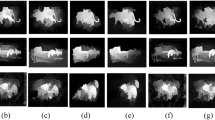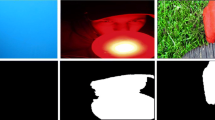Abstract
In recent years, some researchers have put forth the compactness hypothesis, which suggests that similar colours tend to accumulate in the salient region as opposed to the non-salient region in image saliency detection. We discovered that the k-nearest neighbour (kNN) mechanism assumes the presence of similar objects in close proximity. As the kNN method is a supervised learning approach, we introduced an unfixed k value and combined it with the clustering idea of k-means to develop a novel algorithm called kNN clustering. We proposed an object-biased prior and an improved boundary and background prior based on a given compact matrix. Our algorithm was extensively tested on five publicly available datasets. The experimental results demonstrated that it outperformed eight existing top unsupervised models in producing high-quality saliency maps at full resolution. The improved prior methods were particularly effective when employed with existing algorithms lacking prior knowledge, especially with low-performing models.








Similar content being viewed by others
Explore related subjects
Discover the latest articles, news and stories from top researchers in related subjects.Data availability
The datasets generated during and/or analysed during the current study are available in the [Kaggle] repository, [https://www.kaggle.com/datasets].
References
Ullah I, Jian MW, Hussain S, Guo J, Yu H, Wang X, Yin YL (2020) A brief survey of visual saliency detection. Multimedia Tools and Applications 79:34605–34645. https://doi.org/10.1007/s11042-020-08849-y
Itti L, Koch C, Niebur E (1998) A model of saliency-based visual attention for rapid scene analysis. IEEE Transactions on Pattern Analysis and Machine Intelligence 20(11):1665–1672. https://doi.org/10.1109/34.730558
Achanta R, Hemami S, Estrada F, Susstrunk S (2009) Frequency-tuned salient region detection. IEEE Conference on Computer Vision and Pattern Recognition, 1597–1604. https://doi.org/10.1109/cvpr.2009.5206596
Jian M, Qi Q, Dong J, Sun X, Sun Y, Lam KM (2018) Saliency detection using quaternionic distance based weber local descriptor and level priors. Multimedia tools applications 77(11):14343–14360. https://doi.org/10.1007/s11042-017-5032-z
Jian M, Zhou Q, Cui C, Nie X, Luo H, Zhao J, Yin Y (2019) Assessment of feature fusion strategies in visual attention mechanism for saliency detection. Pattern Recogn Lett 127:37–47. https://doi.org/10.1016/j.eswa.2020.114219
Jiang H, Wang J, Yuan Z, Wu Y, Zheng N, Li S (2013) A discriminative regional feature integration approach. Proceedings of the IEEE conference on computer vision and pattern recognition, 2083–2090. https://doi.org/10.1109/cvpr.2013.271
Yan Q, Xu L, Shi JP, Jia JY (2013) Hierarchical saliency detection. In: Proceedings of the IEEE Conference on Computer Vision and Pattern Recognition, 1155–1162. https://doi.org/10.1109/cvpr.2013.153
Li T, Song H, Zhang K, Liu Q, Lian W (2019) Low-rank weighted co-saliency detection via efficient manifold ranking. Multimedia Tools and Applications 78:21309–21324. https://doi.org/10.1007/s11042-019-7403-0
Li X, Lu H, Zhang L, Ruan X, Yang MH (2013) Saliency detection via dense and sparse reconstruction. Proceedings of the IEEE international conference on computer vision, 2976–2983. https://doi.org/10.1109/iccv.2013.370
Chen S, Tan X, Wang B, Hu X (2018) Reverse attention for salient object detection. Proceedings of the European conference on computer vision (ECCV), 234–250. https://doi.org/10.48550/arXiv.1807.09940
Liu N, Han J, Yang MH (2018) Picanet: Learning pixel-wise contextual attention for saliency detection. Proceedings of the IEEE conference on computer vision and pattern recognition, 3089–3098. https://doi.org/10.1109/cvpr.2018.00326
Borji A (2019) Saliency prediction in the deep learning era: Successes and limitations. IEEE transactions on pattern analysis and machine intelligence 43(2):679–700. https://doi.org/10.1109/tpami.2019.2935715
Perazzi F, Krahenbuhl P, Pritch Y, Hornung A (2012) Saliency filters: Contrast based filtering for salient region detection. In: Proceedings of the IEEE Conference on Computer Vision and Pattern Recognition, 733–740. https://doi.org/10.1109/cvpr.2012.6247743
Zhou L, Yang ZH, Yuan Q, Zhou ZT, Hu D (2015) Salient region detection via integrating diffusion-based compactness and local contrast. IEEE Transactions on Image Processing 24:3308–3320. https://doi.org/10.1109/tip.2015.2438546
Kuśmirek W, Szmurło A, Wiewiórka W, Nowak R, Gambin T (2019) Comparison of knn and k-means optimization methods of reference set selection for improved cnv callers performance. BMC Bioinformatics 20:266. https://doi.org/10.1186/s12859-019-2889-z
Bruce N, Tsotsos JK (2005) Saliency based on information maximization. In: Advances in Neural Information Processing Systems 18, 155–162
Hu P, Wang WQ, Zhang C, Lu K (2016) Detecting salient objects via color and texture compactness hypotheses. IEEE Trans Image Process 25(10):4653–4664. https://doi.org/10.1109/tip.2016.2594489
Achanta R, Shaji A, Smith K, Lucchi A, Fua P, Susstrunk S (2012) Slic superpixels compared to state-of-the-art superpixel methods. IEEE Transactions on Pattern Analysis and Machine Intelligence 34(11):2274–2281. https://doi.org/10.1109/tpami.2012.120
Ahmed MJ, Saeed F, Paul A, Jan S, Seo H (2021) A new affinity matrix weighted k-nearest neighbors graph to improve spectral clustering accuracy. PeerJ Computer Science 7:692. https://doi.org/10.7717/peerj-cs.692
Borji A, Cheng MM, Jiang H, Li J (2015) Salient object detection: A benchmark. IEEE transactions on image processing 24(12):5706–5722
Cheng MM, Zhang G, Mitra N, Huang X, Hu S (2011) Global contrast based salient region detectione study. In CVPR. https://doi.org/10.1109/cvpr.2011.5995344
Zhu W, Liang S, Wei Y, Sun J (2014) Saliency optimization from robust background detection. IEEE Conference on Computer Vision and Pattern Recognition, 2814–2821. https://doi.org/10.1109/cvpr.2014.360
Yan Q, Xu L, Shi JP, Jia JY (2013) Hierarchical saliency detection. In: Proceedings of the IEEE Conference on Computer Vision and Pattern Recognition, 1155–1162. https://doi.org/10.1109/cvpr.2013.153
Borji A (2014) What is a salient object? A dataset and a baseline model for salient object detection. IEEE Transactions on Image Processing 24(2):742–756. https://doi.org/10.1109/tip.2014.2383320
Yang C, Zhang L, Lu H, Ruan X, Yang M (2013) Saliency detection via graph-based manifold ranking. IEEE Conference on Computer Vision and Pattern Recognition, 3166–3173. https://doi.org/10.1109/cvpr.2013.407
Borji A, Cheng MM, Hou Q, Jiang H, Li J (2019) Salient Object Detection: A Survey. Computational Visual Media 5(2):117–150. https://doi.org/10.1007/s41095-019-0149-9
Achanta R, Estrada F, Wils P, Süsstrunk S (2008) Salient region detection and segmentation. In:Computer Vision Systems 5008, 66–75. https://doi.org/10.1007/978-3-540-79547-6_7
Hou X, Zhang L (2007) Saliency detection: A spectral residual approach. IEEE Conference on Computer Vision and Pattern Recognition, 1–8. https://doi.org/10.1109/cvpr.2007.383267
Khan A, Wong K (2023) High payload watermarking based on enhanced image saliency detection. Multimedia Tools and Applications 82:15553–15571. https://doi.org/10.1007/s11042-022-13907-8
Margolin R, Tal A, Zelnik-Manor L (2013) What makes a patch distinct? Proceedings of the IEEE conference on computer vision and pattern recognition, 1139–1146. https://doi.org/10.1109/cvpr.2013.151
Zhou J, Jin Z (2013) A new framework for multiscale saliency detection based on image patches. Neural processing letters, 361–374. https://doi.org/10.1007/s11063-012-9276-3
Jian M, Wang J, Yu H, Wang G, Meng X, Yang L, Dong J, Yin Y (2021) Visual saliency detection by integrating spatial position prior of object with background cues. Expert Systems with Applications 168:114219. https://doi.org/10.1016/j.eswa.2020.114219
Wang F, Peng G (2022) Graph construction by incorporating local and global affinity graphs for saliency detection. Signal Processing: Image Communication 105:116712. https://doi.org/10.1016/j.image.2022.116712
Wang F, Cai N, Zhou J, Bai Y, Li J, Wang H (2022) Automatic detection of ultrasound breast lesions: a novel saliency detection model based on multiple priors. Signal, Image and Video Processing 16:723–734. https://doi.org/10.1007/s11760-021-02012-2
Lu X, Jian M, Wang X, Yu H, Dong J, Lam KM (2022) Visual saliency detection via combining center prior and U-Net. Multimedia Systems 28(5):1689–1698. https://doi.org/10.1007/s00530-022-00940-8
Wei Y, Wen F, Zhu W, Sun J (2012) Geodesic saliency using background priors. Computer Vision-ECCV 2012: 12th European Conference on Computer Vision, 29–42. https://doi.org/10.1007/978-3-642-33712-3_3
Jiang HZ, Wang JD, Yuan ZJ, Liu T, Zheng NN, Li S (2011) Automatic salient object segmentation based on context and shape prior. BMVC. https://doi.org/10.5244/c.25.110
Goferman S, Zelnik-Manor L, Tal A (2012) Context-aware saliency detection. IEEE Transactions on Pattern Analysis and Machine Intelligence 34:1915–1926. https://doi.org/10.1109/cvpr.2010.5539929
Parvin N, Kavitha P (2020) Cbir : Color feature extraction using cielab color space with compact color signature. International Journal of Innovative Technology and Exploring Engineering (IJITEE) 9, 470–476. https://doi.org/10.35940/ijitee.f3770.049620
Liu T, Yuan ZJ, Sun J, Wang JD, Zheng NN, O, TX (2011) Learning to detect a salient object. IEEE Transactions on Pattern Analysis and Machine Intelligence 33, 353–367. https://doi.org/10.1109/tpami.2010.70
Zhang J, Sclaroff S (2013) Saliency detection: A boolean map approach. Proceedings of the IEEE international conference on computer vision 33:153–160. https://doi.org/10.1109/iccv.2013.26
Chang KY, Liu TL, Chen HT, Lai SH (2011) Fusing generic objectness and visual saliency for salient object detection. Proceedings of the International Conference on Computer Vision, 914–921. https://doi.org/10.1109/iccv.2011.6126333
Jiang B, Zhang L, Lu H, Yange C, Yange MH (2013) Saliency detection via absorbing markov chain. In: Proceedings of the IEEE International Conference on Computer Vision, 1665–1672. https://doi.org/10.1109/iccv.2013.209
Davis J, Goadrich M (2006) The relationship between precision recall and roc curves. Proceedings of the 23rd international conference on Machine learningJune, 233–240. https://doi.org/10.1145/1143844.1143874
Author information
Authors and Affiliations
Contributions
ZX researched the algorithm and wrote the main manuscript text. SZ and ZR was involved in planning and supervising the work. TY and ZJ revised the manuscript.
Corresponding author
Ethics declarations
Conflict of interest
We declare that there is no conflict of interests regarding the publication of this paper.
Additional information
Publisher's Note
Springer Nature remains neutral with regard to jurisdictional claims in published maps and institutional affiliations.
Rights and permissions
Springer Nature or its licensor (e.g. a society or other partner) holds exclusive rights to this article under a publishing agreement with the author(s) or other rightsholder(s); author self-archiving of the accepted manuscript version of this article is solely governed by the terms of such publishing agreement and applicable law.
About this article
Cite this article
Zhou, X., Ren, Z., Zhou, S. et al. Unsupervised Saliency Detection via kNN Mechanism and Object-Biased Prior. Neural Process Lett 55, 8385–8399 (2023). https://doi.org/10.1007/s11063-023-11316-y
Accepted:
Published:
Issue Date:
DOI: https://doi.org/10.1007/s11063-023-11316-y




